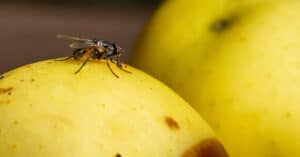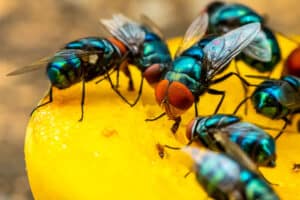Have you ever noticed how many insects, including flies, seem to disappear during the winter? Where do they go? Most flies are not adapted to withstand cold temperatures. Their small size and thin exoskeleton make them vulnerable to heat loss. Additionally, they are unable to generate enough heat internally to keep warm. What does this mean for flies during the winter? If it’s too cold for flies, why do you find one buzzing dazedly around your house, driving your cat crazy? Keep reading to find out!
Description of Flies
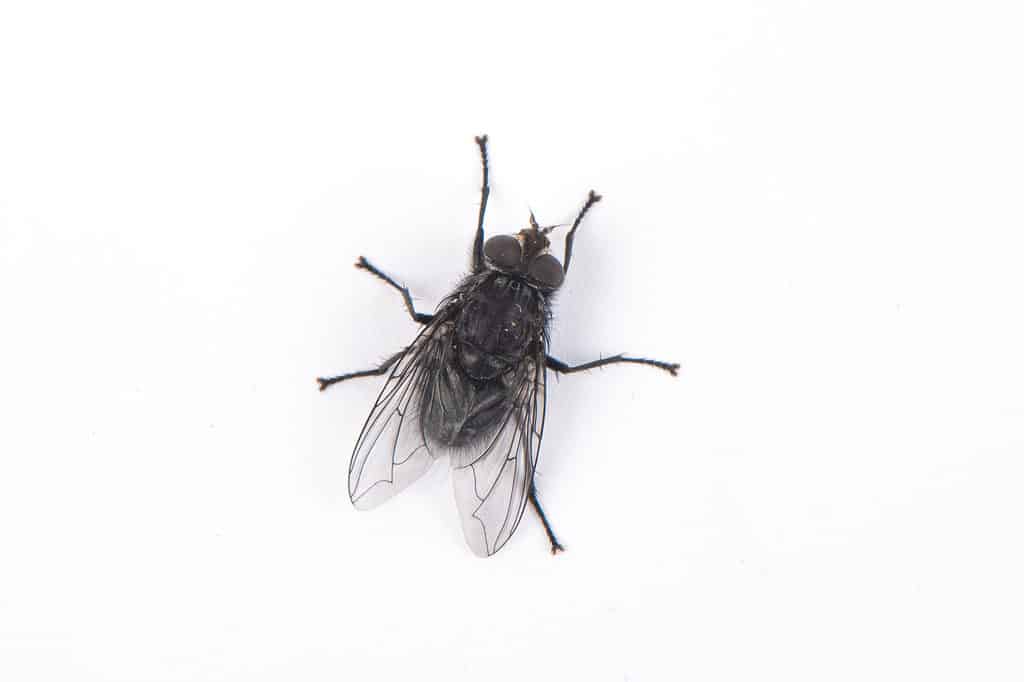
Black flies are infamous for their bites that cause itching, swelling, and inflammation.
©iStock.com/zhikun sun
Flies are a type of insect in the order Diptera that are known for their fast and agile flight. In all, there are over one million species in the Diptera order, including horseflies, robber flies, and mosquitos, among others. Flies are found in a wide variety of habitats. Many species are considered pests due to their association with garbage, feces, and other unsanitary materials. Despite their unsavory reputation, the enormous insect family that we collectively call “flies” plays important roles in pollination, decomposition, and as a food source for other animals.
Flies have a distinct body shape, that helps them maintain balance while in flight. Flies also have large compound eyes and short antennae. Fly wings are usually clear or have a dark color and have a characteristic pattern of veins. Their large eyes allow them to have a wide field of view and detect movement quickly. They feed on a wide range of food sources, such as nectar, fruit, other plant material, feces, and even blood. Flies breed in large numbers and can reproduce quickly, laying their eggs on rotting fruits or feces. They have a short life span, which can last several months, but is most commonly just a couple of weeks.
The Role of Flies in the Ecosystem
Flies play an important role in the ecosystem as they are a primary food source for many species of birds and insects. They also serve as pollinators for some plant species. Their larvae (maggots) can help break down dead plant and animal matter, returning nutrients to the soil. Additionally, some species of flies are important biological control agents, helping to control pests in agriculture. Some species have symbiotic relationships with other organisms, such as ants and beetles, which rely on flies for food.
Flies also have an impact on human activities. Aside from being an awful nuisance flying around people’s faces and food, common house flies can play a role in transmitting over 65 diseases to humans. These include typhoid fever, dysentery, cholera, anthrax, leprosy, and tuberculosis. Around the world, millions of people suffer from serious mosquito-borne illnesses. Zika virus, West Nile virus, dengue, and malaria are just a few.
However, flies also have benefits in human activities. Certain fly species are used in medical research and maggots are used in wound treatment. The grubs of black soldier flies are high in protein and are used as a component of feed for livestock. In East Africa, certain species are ground up to increase the protein content of baked goods, sausage, and meatloaf. They are also eaten roasted or sun-dried.
Habitat of Flies
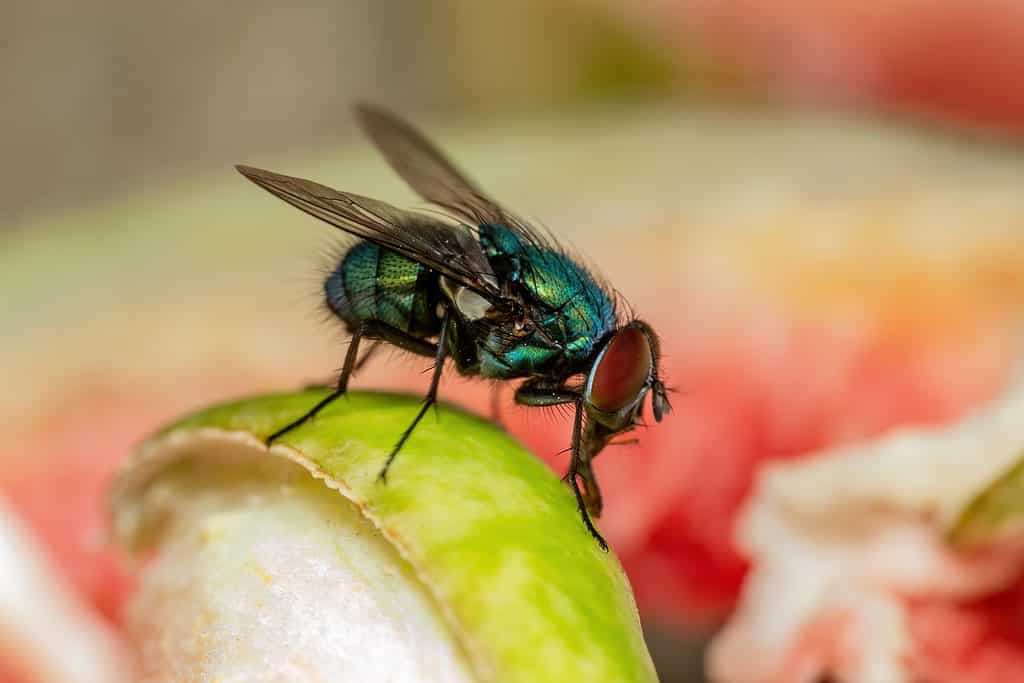
Many species of flies can also be found in urban areas, such as cities and towns.
©nechaevkon/Shutterstock.com
Flies can be found in a wide range of environments, from deserts to rainforests. They thrive in both natural and human-made settings. Some common habitats for flies include:
- Agricultural areas: Many species, such as the house fly and the stable fly, are common in agricultural areas. These include farms, stables, and other livestock facilities. They feed on manure and other organic matter and can breed in large numbers in these environments.
- Urban areas: Many species of flies can also be found in urban areas, such as cities and towns. They can be found in homes, buildings, and other structures, as well as in parks, streets, and other public spaces.
- Woodlands and forests: Species such as the horse fly and the deer fly are common in woodlands and forests. They feed on the blood of animals, such as deer and horses.
- Marshy areas: Some species of Diptera, such as mosquitoes and black flies, are common in marshy and wetlands areas. They breed in standing water.
- Deserts: The Sonoran Desert fly is common in deserts and are adapted to survive in hot and dry conditions.
Behavior of Flies
Flies have a diverse range of behavior patterns, depending on the species. Here are a few examples of common fly behaviors:
- Feeding: Many species feed on a wide range of food sources, such as nectar, fruit, and other plant material. Some flies, such as the house fly and the stable fly, feed on feces and other organic matter. Other species, such as the horse fly and the deer fly, feed on the blood of animals.
- Breeding: Many species of flies breed in large numbers and can reproduce quickly. Some species, such as the house fly and the stable fly, breed in feces and other organic matter. Other species, such as mosquitoes and black flies, breed in standing water. Some fly species will lay eggs on a specific host or food source, like rotting fruit.
- Migration: Some flies, such as the tsetse fly, will migrate over long distances, often in response to changing environmental conditions. They may move to new areas to find food and breeding sites.
- Diurnal and nocturnal activity: Some species are active during the day, while others are active at night. For example, the house fly is active during the day, while the cluster fly is active at night.
- Behavioral patterns: Some flies, like fruit flies, are attracted to light. They are commonly found in areas with bright lights, such as kitchens and bathrooms. Other flies, like the blowfly, are attracted to decaying organic matter. They are commonly found in areas where food is stored or where garbage is present.
Different fly species have different behaviors and can vary depending on the region, climate, and time of year.
What Flies Do in the Winter
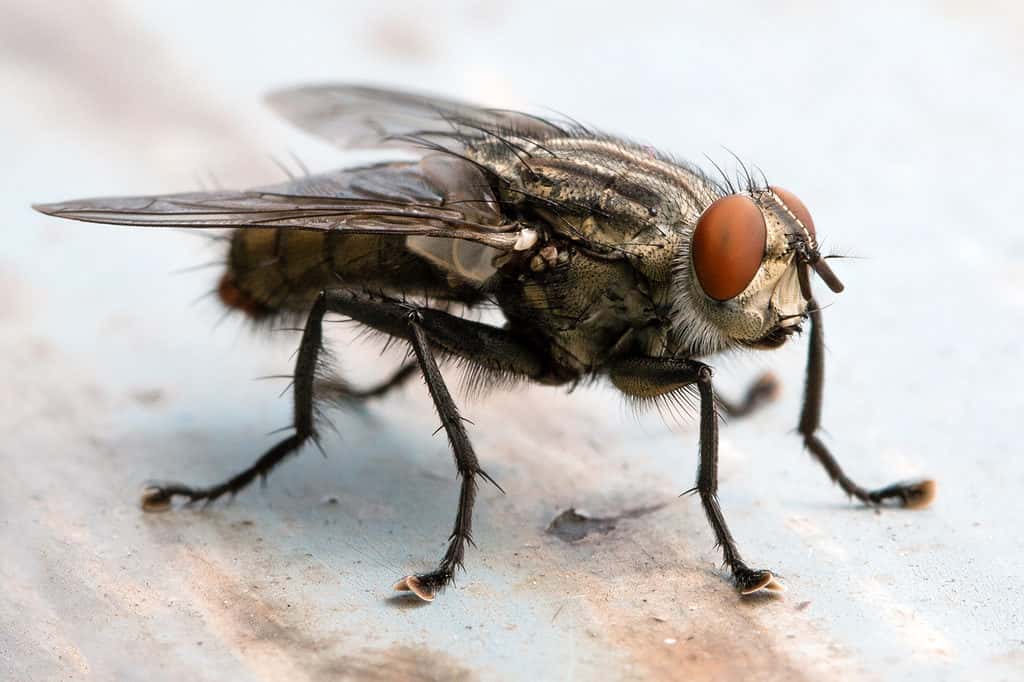
The most common fly species Americans are likely to find in their houses in winter are cluster flies, fruit flies, or house flies.
©Abel Tumik/Shutterstock.com
So, what do flies do in the winter? Basically, some species die off in the winter, leaving behind grubs buried in the ground to hatch in spring. Others seek out a warm place to spend the winter, such as a cave, a barn, or your house. Usually, they are in a state of diapause, which is not exactly hibernation, but a period of reduced metabolism. That’s why it’s not surprising on a particularly warm winter day to find a groggy fly crawling on your windowsill.
The most common species Americans are likely to find inside in winter are cluster flies, fruit flies, or house flies.
Cluster Flies
Cluster flies are big, fat, darkly colored creatures. They lay their eggs on earthworms. During the winter, the maggots gradually eat their way through the worm. They live inside its husk until they are ready to emerge in spring. Adult cluster flies find their way inside your house through cracks. You’ll sometimes find them flying around windows, attics, and basements. They prefer warmer places where they can enter diapause with a cluster of their own kind. On a warm winter day, they will buzz around lethargically, thinking it might be spring.
Fruit Flies
Fruit flies are small, light-colored, and have red eyes. They often get into your home inside grocery bags. You’re most likely to see them in the kitchen. They seek out warm moist places to lay eggs, like rotting plant material. Unsurprisingly, you’re likely to see them around garbage or the sink drain. In the winter, they nestle into garbage for warmth. If you live in a cold climate, all it takes is fruit from a warmer climate to bring them around.
House Flies
House flies spend the winter in cracks and crevices of your home in a state of diapause. In the spring, they return to normal and emerge and lay eggs on decaying organic matter, usually vegetable matter. The eggs hatch as larvae called maggots, which go through three molts, getting bigger each time. Then they go through a pupa stage in a hard red-brown shell before finally hatching into adult flies.
What Can You Do to Get Rid of Flies?
Keeping flies out of your house can be a real pain. It’s much easier to prevent the problem than to let it get out of control. Here are some essential preventative measures:
- Keep surfaces clean: Flies are attracted to food and other organic matter, so it is important to keep surfaces clean and free of crumbs and spills. Regularly cleaning and disinfecting surfaces, particularly in the kitchen, can help prevent flies from entering and breeding.
- Seal entry points: Flies can enter your home through small cracks and crevices. It’s important to seal any entry points, such as windows, doors, and vents, to prevent them from entering.
- Use natural repellents: Certain essential oils, such as peppermint and eucalyptus, can be used to repel flies. You can use them in diffusers or spray them around the house to keep flies away.
If you’re already dealing with an infestation, here are some suggestions to deal with the problem:
- Use fly traps: Several types of traps are available, such as sticky fly tapes, fly paper, and electronic fly zappers. These traps can be effective in catching flies that are already inside the house.
- Try a vacuum cleaner: Flies actually are not very fast, especially in winter. A vacuum cleaner can be the easiest way to remove an annoying fly from a window. Be sure to seal and discard the vacuum bag to prevent them from escaping and avoid odors from decaying insects.
- Professional Pest Control: If the infestation is severe, it may be necessary to hire a professional pest control service. They have specialized tools and knowledge to get rid of flies and prevent them from returning.
The photo featured at the top of this post is © Abel Tumik/Shutterstock.com
Thank you for reading! Have some feedback for us? Contact the AZ Animals editorial team.



